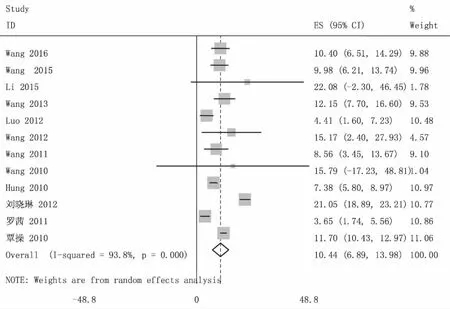王海燕,石修权,覃 明,董 蕾,李 童
(1.复旦大学公共卫生学院 环境卫生学教研室,上海 200032;2.遵义医学院 公共卫生学院,贵州 遵义 563099;3.遵义医学院免疫学教研室暨贵州省医学研究生教育创新基地,贵州 遵义 563099;4.齐鲁制药有限公司,山东 济南 250100;5.虹口区疾病预防控制中心,上海 200082)
基础医学研究
我国饮用水中亚硝胺类消毒副产物暴露水平的Meta分析
王海燕1,2,石修权2,覃 明3,董 蕾1,4,李 童1,5
(1.复旦大学公共卫生学院 环境卫生学教研室,上海 200032;2.遵义医学院 公共卫生学院,贵州 遵义 563099;3.遵义医学院免疫学教研室暨贵州省医学研究生教育创新基地,贵州 遵义 563099;4.齐鲁制药有限公司,山东 济南 250100;5.虹口区疾病预防控制中心,上海 200082)
目的 探讨我国饮用水中亚硝胺类(Nitrosamines,NAms)消毒副产物(Disinfection by-products,DBPs)的暴露水平及暴露特征。方法 系统检索1996年至2016年公开发表的关于中国饮用水处理厂原水、各工艺环节处理水、出厂水及管网水中NAms类DBPs暴露情况的文献。检索数据库包括维普中文期刊数据库、中国知网(CNKI)、万方数据库、Web of science、Pubmed及Google Scholar中收录的中英全文。文献检索关键词为:“亚硝胺”“消毒副产物”“饮用水”检索字段均为全文任意字段。采用Meta分析对检索到的有关我国饮用水中NAms类DBPs暴露情况的研究结果进行综合分析。结果 我国饮用水处理厂原水、各工艺环节处理水、出厂水及管网水中均有NAms类DBPs被检出,检出种类为9种,浓度均为ng/L级,其中N-亚硝基二甲胺(N-Nitrosodimethylamine,NDMA)是检出率和检出浓度最高的一类,最高浓度达78.93 ng/L;采用氯胺消毒的水厂NAms类DBPs在出厂水中浓度比原水中浓度明显升高;生物活性炭的使用可降低出厂水中NAms类DBPs的浓度;我国饮用水中NAms污染可来自原水或氯胺消毒过程。结论 我国饮用水中NAms污染可来自原水或氯胺消毒过程;我国饮用水NAms类DBPs在出厂水与管网水中检出率较高者为NDMA、N-亚硝基二乙胺(N-nitrosodiethylamine,NDEA)及N-亚硝基甲基乙基胺(N-Nitrosomethyl ethylamine,NMEA),其平均浓度在出厂水中分别为10.44、5.62和3.33 ng/L,在管网水中分别为11.89、4.64和6.10 ng/L。
Meta分析;饮用水;亚硝胺;消毒副产物
饮用水消毒剂能控制介水传染病发生,但同时可与水中某些前体物(有机物或无机物)反应[1-2],生成对人体健康有潜在威胁的消毒副产物(Disinfection by-products,DBPs)[3-4]。亚硝胺(Nitrosamines,NAms)是含氮类DBPs的一类,可引起实验动物多器官肿瘤而备受关注[5-8],目前尚没有国家或国际性组织对含氮类DBPs制定饮用水卫生标准。目前已确认的饮用水中有9类NAms类DBPs,分别为:N-亚硝基二甲胺(N-Nitrosodimethylamine,NDMA)、N-亚硝基二乙胺(N-nitrosodiethylamine,NDEA)、N-亚硝基甲基乙基胺(N-Nitrosomethyl ethylamine,NMEA)、N-亚硝基吗啉(N-nitrosomorpholine,NMOR)、N-亚硝基吡咯烷(N-nitrosopyrrolidine,NPYR)、N-亚硝基二丁胺(N-nitrosodi-n-butylamine,NDBA)、N-亚硝基二丙胺(N-nitrosodi-n-propylamine,NDPA)、N-亚硝基哌啶(N-nitrosopiperidine,NPIP)和N-亚硝基二苯胺(N-nitrosodiphenylamine,NDPhA)[9-17]。以往对NAms类DBPs暴露研究主要集中在美国、加拿大、澳大利亚和日本等发达国家,近些年,我国对其也相继展开了研究[18],因此,汇总我国NAms类DBPs的暴露情况,对认识我国饮用水中NAms类DBPs污染现状及潜在危害、健康风险评估和饮用水卫生标准的制定意义重大。
1 资料与方法
1.1 资料来源
1.1.1 检索范围、策略 系统检索1996年1月至2016年12月公开发表的关于中国饮用水处理厂原水、各工艺环节处理水、出厂水及管网水中NAms类DBPs暴露情况的文献报道。检索数据库包括维普中文期刊数据库、中国知网(CNKI)、万方数据库、Web of science、Pubmed及Google Scholar中收录的中英全文。文献检索关键词为:“亚硝胺”“消毒副产物”“饮用水”,检索字段均为全文任意字段,相应的英文检索式为N-nitrosamines and[(Disinfection Byproducts)OR DBPs]AND(Drinking Water)AND(China OR Chinese)进行模糊匹配检索,通过计算机检索并结合参考文献追溯法,确定涉及中国饮用水中NAms类DBPs暴露情况的文献。
1.1.2 筛选合格文献 文献纳入标准:①研究对象为中国地区饮用水处理厂中原水、各消毒环节水、出厂水及管网水中NAms类DBPs;②检测物质为9种NAms类DBPs的一种或多种;③有明确的水处理工艺过程和消毒方式;④水样采集地点、采样方法、运输、储存、萃取等水样前处理方法有明确说明;⑤水样检测方法有明确说明且采用国家或国际标准;⑥居民直接饮用水样检测,如超市矿泉水中NAms类DBPs含量检测报道;⑦研究结果报道了拟检测NAms类DBPs种类,检出种类,样本数及检测浓度。排除标准:①文献发表年限超过20年;②特殊地区如受NAms化学物工业污染地区;③污水处理厂、河水等水源水中NAms类DBPs的暴露水平研究;④重复发表的文章、综述;⑤设计有明显缺陷、检测方法不符合标准的、信息不完整的或经核查统计计算出现错误的;⑥研究NAms类DBPs检测方法未给出具体水样中NAms类DBPs的文献;⑦会议摘要。
1.1.3 信息提取 用Excel和Word建立数据库从合格文献中提取文献信息,摘录以下内容:文章标题、杂志、第一作者、通讯作者、发表时间、采样时间、采样地点、采样流程、样本数、饮用水处理厂采用的消毒方法、消毒剂的种类、水样预处理方法、检测方法、检测物质、原水、各消毒工艺环节(预加氯、混凝沉淀、过滤、活性炭、臭氧等)、出厂水和管网水中NAms类DBPs的检出种类与浓度。
1.1.4 质量控制 文献检索、文献筛选、信息摘录和文献质量评价均由两名受过培训的人员独自进行。当文献整理过程中出现疑问或意见不一致时,通过集中讨论或咨询第三方解决。
1.2 统计学方法 对纳入的文献,采用广义倒方差模型,分析汇总NAms类DBPs在出厂水和管网水中的暴露浓度。应用Stata12.0软件检验异质性、绘制森林图、评估发表偏倚。
1.2.1 异质性检验 采用χ2检验和Higgins等[19]提出检验统计量I2对纳入的文献进行异质性检验,I2从森林图中获得。若异质性结果P>0.05和I2<0.5,表明资料的同质性较好,选择固定效应模型计算合并效应量;若异质性结果P<0.05和(或)I2>0.5,表明资料存在明显异质性,则选择随机效应模型计算合并效应量。
1.2.2 汇总分析 应用Stata12.0软件绘制森林图表示汇总分析结果。
1.2.3 发表偏倚评价 应用Stata12.0软件制作漏斗图分析结果是否存在发表偏倚。如果资料存在偏倚,会出现不对称的漏斗图,不对称越明显,偏倚程度越大[20]。
2 结果
2.1 文献的基本情况 数据库系统检索得到中英文文献分别为62篇和57篇,根据图1的文献筛选流程逐步仔细阅读筛选文献。由文章标题排除重复的文献;阅读摘要排除关于NAms类DBPs检测方法、形成机理等报道;通过阅读全文依据纳入标准与排除标准排除不合格文献,最后仔细核对原文数据,进行多轮筛选得到合格的中文文献5篇[11,21-24],英文文献9篇[12-17,25-27]。文献中报道了所研究的地区某一个或多个饮用水厂中原水、各工艺环节处理水、出厂水或管网水中一种或多种NAms类DBPs的暴露情况,文献信息(见表1)。

图1 文献筛选流程图
2.2 异质性检验 文献异质性检验显示(见表2),出厂水NDMA(χ2=178.45,I2=93.8%),NMEA(χ2=372.27,I2=99.5%),NDBA(χ2=12.28,I2=83.7%),NMOR(χ2=38.15;I2=84.3%);管网水NDMA(χ2=20.25,I2=80.2%),NMEA(χ2=90.08,I2=97.8%),NDEA(χ2=19.47,I2=77.9%),P均小于0.05,具有明显的异质性,因此选择随机效应模型合并效应量;而出厂水NDEA(χ2=3.18,I2=37.5%),NPYR(χ2=6.83,I2=26.8%),NDPhA(χ2=0.56,I2=0.0%),P均大于0.05,具有明显的同质性,采用固定效应模型。
2.3 发表偏倚的评价 由发表偏倚结果(见表2)Egger检验统计量,P均大于0.05,并结合漏斗图(图形略),提示本研究发表偏倚可以排除。
表1 纳入文献的基本情况

文献时间消毒剂检测方法及种类水样类型所测NAms种类Wangetal.2016[25]2010.3-4传统氯化消毒UPLC-ESI-MS/MS检测9种NAms原水、出厂水NDMA/NDBA/NDEALietal.2015[26]2012.6-72012.11-2013.1传统氯化消毒GC-MS检测9种NAms原水、出厂水管网水NDMA/NMOR/NPYR/NDPhA/NPIP/NDPA/NMEA/NDBA/NDEAWangetal.2015[27]2015传统氯化消毒改良SPE-LC/MS/MS检测9种NAms原水、出厂水中间工艺水NDMA/NMOR/NPYRWangetal.2013[15]2010.7一氯胺SPE-UPLC-MS/MS检测9种NAms原水、出厂水、中间工艺水、管网水NDMA/NMOR/NPYRWangetal.2012[16]-氯胺UPLC-MS/MS检测9种NAms原水、中间工艺水、出厂水、管网水NDMA/NMOR/NPYR/NMEA/NDPhA/NPIP/NDPALuoetal.2012[13]2009.11-2010.4氯、氯胺、UV和O3SPE-UPLC-MS/MS检测9种NAms原水、中间工艺水、出厂水、管网水NDMA/NMOR/NPYR/NMEA/NDBA/NDEA/NDPhA/NPIP/NDPAWangetal.2011[14]2010.11-12O3-BAC氯胺;氯UPLC-ESI-MS/MS检测9种NAms原水、出厂水NDMA/NMOR/NDEA/NDPhA/NMEA/NDBAWangetal.2010[17]2009.3氯、氯胺、O3-BACUPLC-MS/MS检测NDMA原水、中间工艺水、出厂水、管网水NDMAHungetal.2010[12]2007.8-2008.5传统氯化消毒SPME-GC/MS/MS检测4种NAms原水、中间工艺水、出厂水、管网水NDMA刘晓琳etal.2012[11]2011.7氯气GC-MS检测8种NAms原水、中间工艺水、出厂水、管网水NDMA/NDPA罗茜etal.2011[21]2009.冬氯胺UPLC-MS/MS检测9种NAms原水、中间工艺水、出厂水NDMA/NMOR/NDBA/NPYR/NDEA覃操etal.2010[22]-O3-BAC氯液质联用仪检测NDMA原水、中间工艺水、出厂水NDMA梁闯etal.2009[23]--SPE/LC/MS/MS检测NDMA管网水NDMA董蕾etal.2016[24]2015.6-2016.1臭氧-氯组合消毒GC/MS出厂水、管网水NDMA/NMEA/NDPA/NDEA/NPIP/NMOR/NPYR/ND-PA
传统常规氯化消毒:预加氯,沉淀,混凝,过滤后加氯等。
表2 我国NAms类DBPs暴露水平Meta分析异质性检验与偏倚情况

水源NAms文献异质性检验χ2PI2合并效应量浓度(ng/L)Egger检验统计量P出厂水NDMA178.45<0.0193.8%10.440.960.36NMEA372.27<0.0199.5%3.330.550.97NDEA3.81>0.0537.5%5.62-0.040.97NDBA12.28<0.0183.7%1.4111.060.08NMOR38.15<0.0184.3%3.551.360.23NPYR6.83>0.0526.8%2.38-0.780.48NDPhA0.56>0.050.0%1.80-1.640.35管网水NDMA20.25<0.0580.2%11.890.250.82NMEA90.08<0.0597.8%6.100.800.57NDEA19.47<0.0577.9%4.640.600.72
2.4 效应值的合并——NAms类DBPs暴露浓度 森林图结果显示(见图2、图3),出厂水中NDMA和NPYR总合并效应量分别为10.44和2.38 ng/L;其余NAms类DBPs(森林图略),NDEA、NMEA、NDBA、NMOR和NDPhA的总合并效应量分别为5.62、3.33、1.41、3.55和1.80 ng/L。管网水中NDMA、NDEA和NMEA的总合并效应量分别为11.89、4.64和6.10 ng/L(森林图略)。除上述NAms外,其他文献报道均未满3篇文献报道,可直接取其中位数浓度。

图2 饮用水厂出厂水中NDMA含量Meta分析森林图(随机效应模型,单位:ng/L)

图3 饮用水厂出厂水中NPYR含量Meta分析森林图(固定效应模型,单位:ng/L)
3 讨论
Meta分析是以同一主题的多项独立研究的结果为研究对象,在严格的设计基础上,运用适当的统计学方法对多个研究结果进行系统、客观、定量的综合分析[28]。本文通过检索多个生物医学数据库,对纳入的14篇不同地区、不同时间我国饮用水中NAms类DBPs暴露情况的数据进行分析,针对不同的物质采用相应的随机效应模型或固定效应模型合并效应量,并得出95%CI。
饮用水中NAms类DBPs可通过氯胺及氯化消毒产生,包含多种化学物,均含有N-N=O基团,其毒效应远远大于三卤甲烷等传统消毒副产物。本文通过Meta汇总分析我国饮用水中NAms类DBPs暴露水平及构成特征,为后续饮用水中NAms化学物低剂量混合暴露毒性研究提供剂量参考依据。
目前,国外研究报道饮用水中已检测出9种NAms类DBPs,常以多种类共同被检出,浓度均为ng/L[11]。尽管NAms类DBPs在饮用水中的浓度很低,但在许多生物测试系统中均显示具有遗传毒性[29],可致基因突变、DNA损伤、染色体断裂等[30-31]。遗传毒性是饮用水卫生标准研制和饮用水安全评价关注的首要问题[32]。然而,饮用水中NAms类DBPs的含量极低,现有NAms类DBPs的遗传毒性主要针对单一物质,采用极高染毒剂量获得,两者暴露水平相差千百万倍[33-34];很少有研究关注饮用水中NAms类DBPs现实低剂量混合暴露的遗传毒性及其毒效应分子机制,现有毒理学数据并不能准确评估目前饮用水中NAms类DBPs的遗传毒性。因此,开展以现实暴露特征为基础的饮用水NAms类DBPs遗传毒性、潜在致癌性及可能的毒性效应通路研究,对于准确认识和评价其健康风险具有重要价值。
本文结果显示,近20年有关中国饮用水处理厂原水、各工艺环节处理水、出厂水及管网水中均有NAms类DBPs被检出,检出种类亦为9种,浓度亦为ng/L级,与其他国家研究结果类似;采用氯胺消毒的饮用水厂NAms类DBPs在出厂水中浓度比原水中浓度明显升高;生物活性炭的使用可降低出厂水NAms类DBPs的浓度;我国饮用水中NAms污染可来自原水或氯胺消毒过程。我国饮用水中NDMA是9种NAms检出率和检出浓度最高的一类,最高浓度达78.93 ng/L;其次,出厂水中检出频率较高的为NDEA、NMEA、NMOR和NPYR,最高浓度分别达到8.05、68.5、14.8和13.4 ng/L;管网水中检出频率较高的为NDEA、NMEA、NMOR和NPYR,最高浓度达9.5、9.7、12.1和13.0 ng/L。本文分析汇总9类NAms类DBPs的暴露水平,其中暴露率较高的3种NAms类DBPs平均浓度:出厂水中NDMA、NDEA和NMEA为10.44、5.62和3.33 ng/L;管网水中11.89、4.64和6.10 ng/L。根据NAms类DBPs在中国饮用水中的暴露情况,结合国际癌症组织(IARC)对NAms类DBPs的癌症分级可为后续以基础暴露剂量为基础的单一或混合暴露遗传毒性及毒性通路研究提供基础数据。
[1] Krasner S W,Weinberg H S,Richardson S D,et al.Occurrence of a new generation of disinfection byproducts[J].Environ Sci Technol,2006,40(23):7175-7185.
[2] Hrudey S E.Chlorination disinfection by-products,public health risk tradeoffs and me[J].Water Research,2009,43(8):2057-2092.
[3] Richardson S D.Water analysis:emerging contaminants and current issues[J].Analytical Chemistry,2009,81(12):4645-4677.
[4] Jurado-Sanchez B,Ballesteros E,Gallego M.Occurrence of aromatic amines and N- nitrosamines in the different steps of a drinking water treatment plant[J].Water Res,2012,46(14):4543-4555.
[5] Choi J,Valentine R L.Formation of N-nitrosodimethylamine(NDMA)from reaction of monochloramine:a new disinfection by-product[J].Water Res,2002,36(4):817-824.
[6] Plewa M J,Wagner E D,Jazwierska P,et al.Halonitromethane drinking water disinfection byproducts:Chemical characterization and mammalian cell cytotoxicity and genotoxicity[J].Environmental Science & Technology,2004,38(1):62-68.
[7] Muellner M G,Wagner E D,McCalla K,et al.Haloacetonitriles vs.regulated haloacetic acids:Are nitrogen-containing DBPs more toxic?[J].Environmental Science & Technology,2007,41(2):645-651.
[8] Plewa M J,Muellner M G,Richardson S D,et al.Occurrence,synthesis,and mammalian cell cytotoxicity and genotoxicity of haloacetamides:An emerging class of nitrogenous drinking water disinfection by-products[J].Environmental Science & Technology,2008,42(3):955-961.
[9] Wagner E D,Hsu K M,Lagunas A,et al.Comparative genotoxicity of nitrosamine drinking water disinfection byproducts in Salmonella and mammalian cells[J].Mutat Res,2012,741(1-2):109-115.
[10] Shah A D,Mitch W A.Halonitroalkanes,halonitriles,haloamides,and N- nitrosamines:A critical review of nitrogenous disinfection byproduct formation pathways[J].Environ Sci Technol,2012,46(1):119-131.
[11] 刘晓琳,郑唯韡,韦霄,等.江苏省某水厂含碳、含氮和碘系消毒副产物现况调查[J].中华预防医学杂志,2012,46(2):133-138.
[12] Hung H W,Lin T F,Chiu C H,et al.Trace Analysis of N-Nitrosamines in water using solid-phase microextraction coupled with gas chromatograph-tandem mass spectrometry[J].Water,Air,& Soil Pollution,2010,213(1-4):459-469.
[13] Luo Q D,Wang D H,Wang Z J.Occurrences of nitrosamines in chlorinated and chloraminated drinking water in three representative cities,China[J].Science of The Total Environment,2012,437(20):219-225.
[14] Wang W F,Ren S Y,Zhang H F,et al.Occurrence of nine nitrosamines and secondary amines in source water and drinking water:potential of secondary amines as nitrosamine precursors[J].Water Research,2011,45(16):4930-4938.
[15] Wang C,Wang C K,Zhang X J,et al.Effects of organic fractions on the formation and control of N-nitrosamine precursors during conventional drinking water treatment processes[J].Science of The Total Environment,2013,449(2):295-301.
[16] Wang C K,Zhang X J,Wang J,et al.Detecting N-nitrosamines in water treatment plants and distribution systems in China using ultra-performance liquid chromatography-tandem mass spectrometry[J].Frontiers of Environmental Science & Engineering,2012,6(6):770-777.
[17] Wang W W,Hu J Y,Yu J W,et al.Determination of N-nitrosodimethylamine in drinking water by UPLC-MS/MS[J].Journal of Environmental Sciences,2010,22(10):1508-1512.
[18] Wei X,Chen X,Wang X,et al.Occurrence of regulated and emerging iodinated DBPs in the Shanghai drinking water[J].Plos One,2013,8(3):59677.
[19] Higgins J P,Thompson S G,Deek J J,et al.Measuring inconsistency in meta-analyses[J].British Medical Journal,2003,327(7414):557-560.
[20] 李幼平.循证医学[M].第2版.北京:高等教育出版社,2009:83-85.
[21] 罗茜,王东红,王炳一,等.超高效液相色谱串联质谱快速测定饮用水中9种N-亚硝胺的新方法[J].中国科学:化学,2011,41(1):82-90.
[22] 覃操,徐斌,夏圣骥,等.饮用水处理工艺中NDMA的生成与去除特性研究[J].中国给水排水,2010(21):16-20.
[23] 梁闯,徐斌,夏圣骥,等.SPE/LC/MS/MS检测水中痕量二甲基亚硝胺[J].中国给水排水,2009,25(14):82-85,92.
[24] 董蕾,王海燕,蔡宏权,等.我国六城市饮用水中含氮类消毒副产物的现况调查[J].环境与健康杂志,2016,33(3):232-235.
[25] Wang W W,Yu J W,An W,et al.Occurrence and profiling of multiple nitrosamines in source water and drinking water of China[J].Science of the Total Environment,2016,551-552:489-495.
[26] Li T,Yu D,Xian Q,et al.Variation of levels and distribution of N- nitrosamines in different seasons in drinking waters of East China[J].Environ Sci Pollut Res,2015,22(15):11792-11800.
[27] Wang C,Liu S,Wang J,et al.Monthly survey of N-nitrosamine yield in a conventional water treatment plant in North China[J].Journal of Environment Sciences,2015,38(12):142-149.
[28] 李幼平.循证医学[M].第3版.北京:高等教育出版社,2013:98.
[29] Richardson S D,Plewa M J,Wagner E D,et al.Occurrence,genotoxicity,and carcinogenicity of regulated and emerging disinfection by-products in drinking water:a review and roadmap for research[J].Mutat Res,2007,636(1-3):178-242.
[30] Wagner E D,Osiol J,Mitch W A,et al.Comparative in vitro toxicity of nitrosamines and nitramines associated with amine-based carbon capture and storage[J].Environmental Science & Technology,2014,48(14):8203-8211.
[31] Mori Y,Tatematsu K,Koide A,et al.Modification by curcumin of mutagenic activation of carcinogenic N-nitrosamines by extrahepatic cytochromes P-450 2B1 and 2E1 in rats[J].Cancer Science,2006,97(9):896-904.
[32] Hebert A,Forestier D,Lenes D,et al.Innovative method for prioritizing emerging disinfection by-products(DBPs)in drinking water on the basis of their potential impact on public health[J].Water Res,2010,44(10):3147-3165.
[33] Wang S,Tian D,Zheng W,et al.Combined exposure to 3-chloro-4-dichloromethyl-5- hydroxyl-2(5H)-furanone and microsytin-LR increases genotoxicity in Chinese hamster ovary cells through oxidative stress[J].Environmental Science & Technology,2013,47(3):1678-1687.
[34] Wang S,Zhang H,Zheng W,et al.Organic extract contaminants from drinking water activate Nrf2-mediated antioxidant response in a human cell line[J].Environmental Science & Technology,2013,47(9):4768-4777.
[收稿2017-03-23;修回2017-04-13]
(编辑:王静)
The exposure level of nitrosamines disinfection by-products in drinking water of China:a Meta analysis
WangHaiyan1,2,ShiXiuquan2,QinMing3,DongLei1,4,LiTong5
(1.Department of Environmental Health,School of Public Health,Fudan University,Shanghai 200032,China;2.School of Public Health,Zunyi Medical University,Zunyi Guizhou 563099,China;3.Department of Immunology and Immunology Innovation Base of Postgraduate Education,Zunyi Medical University,Zunyi Guizhou 563099,China;4.Qilu Pharmaceutical Co.,Ltd,Shandong Jinan,250100,China;5.Hongkou Center for Disease Control and Prevention,Shanghai 200082,China)
Objective To evaluate exposure of nitrosamines (NAms) in drinking water from various regions of China.Methods Literatures published between 1991-2016 which consisting of the exposure of NAms disinfection by-products(DPBs)in source water,raw water,clearing water,finished water and tap water at drinking water treatment plants of China were reviewed from Weipu database,CNKI,Wangfang database,Web of science,Pub med and Google Scholar.We searched papers involving exposure to NAms in English and Chinese with the key word of "nitrosamine","disinfection by-products" and "drinking water".We evaluate the exposure of NAms by conducting Meta analysis.Results These reports demonstrate that NAms were all detected out in source water,raw water,clearing water,finished water and tap water and the level were ng/L.The results showed that N-Nitrosodimethylamine(NDMA)is the most frequently detected with highest concentration in the drinking water with the highest concentration of 78.93 ng/L.Chloramine disinfection generated more NAms and biological activated carbon disinfection produce less NAms than conventional disinfection technologies.These researches show that NAms in drinking water derived from source water or chloramine disinfection process.Conclusion NAms can derive from source water or chloramine disinfection in drinking water of China.NDMA,N-nitrosodiethylamine(NDEA)and N-Nitrosomethylethylamine(NMEA)are the most frequently detected in the finished water and tap water of China.The average concentration of NDMA,NDEA,NMEA are 10.44,5.62,3.33 ng/L in finished water,and 11.89,4.64 and 6.10 ng/L in tap water of China.
Meta analysis;drinking water;nitrosamines;disinfection by-products
R123.1
A
1000-2715(2017)03-0278-07



